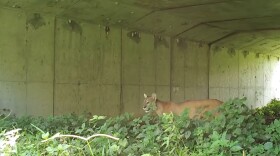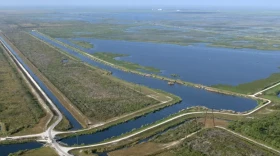While trucks haul in about 70,000 tons of new sand to replace what mother nature took away in Northwest Sanibel there are also crews hard at work on an erosion trouble spot that Hurricane Ian made much worse near Sanibel Captiva road.
And all that effort is not just about restoring the beach for sunbathers — the 3,200 truckloads of sand needed to complete the job also serve as a vital barrier against waves that can destroy this critical road.
“That road is the only way folks can evacuate from Captiva Island and a portion of Northwestern Sanibel. So it's a key part of our evacuation infrastructure for that part of the county,” said Steve Boutelle, the Marine Operations Manager with Lee County Natural Resources Division.
Combatting mother nature’s impact comes with a considerable price tag in Lee County with at least 50 million dollars to repair erosion loss caused by Ian from Boca Grande to Bonita. But this particular project isn’t optional.
“Because we know we're going to have additional waves that are going to come in and attack that shoreline," Boutelle said. “We know for sure that in the wintertime, the cold fronts will start coming through and sort of over the long term. Those are the weather events that cause a lot of our background erosion. So we need to get the sand out there as soon as we can.”
Boutelle said his team looks for the most cost-effective way to source the sand. Sometimes crews can get it from offshore if a large amount of it nearby can be easily moved. Not in this particular case — the storm washed the sand offshore.
“Given the amount of sand we need — in this case we're turning inland. And we're looking at some of the really relic beach deposits that are now in shore," Boutelle said. "And so we're dealing with what used to be beach sand, and is now coming out of private mines that are able to meet all of the standards that come to us from the state to be able to match the sand quality in terms of the size and the color that we expect to see out on our beaches."
That matching sand is coming from the Immokalee area — but beach goers shouldn’t be the wiser
“About the only thing they're going to notice different is that we're used to seeing all those shells on our beaches, the sand that's coming out of the mine won't have that initially. So until the sand kind of moves around and the shells mix back in it will look a little different from that perspective. But that should be about it,” Boutelle said.
Boutelle said that steps are also being made to protect the animals that depend on these beaches. The county works with state-approved foundations to make sure creatures like –sea turtles who might lay eggs here have their nests safely relocated.
WGCU is your trusted source for news and information in Southwest Florida. We are a nonprofit public service, and your support is more critical than ever. Keep public media strong and donate now. Thank you.








